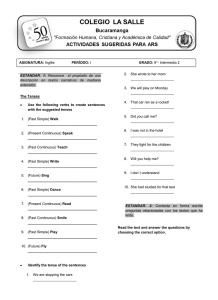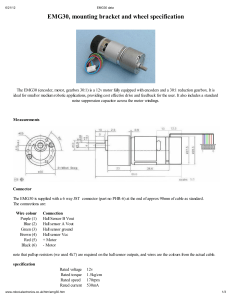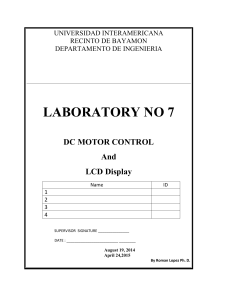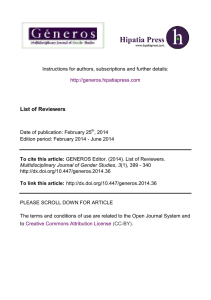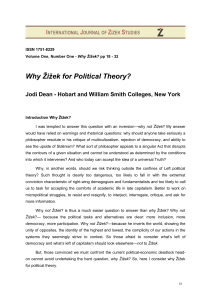Active Play vs. Skill-Based Learning: Preschool Motor Skills
Anuncio
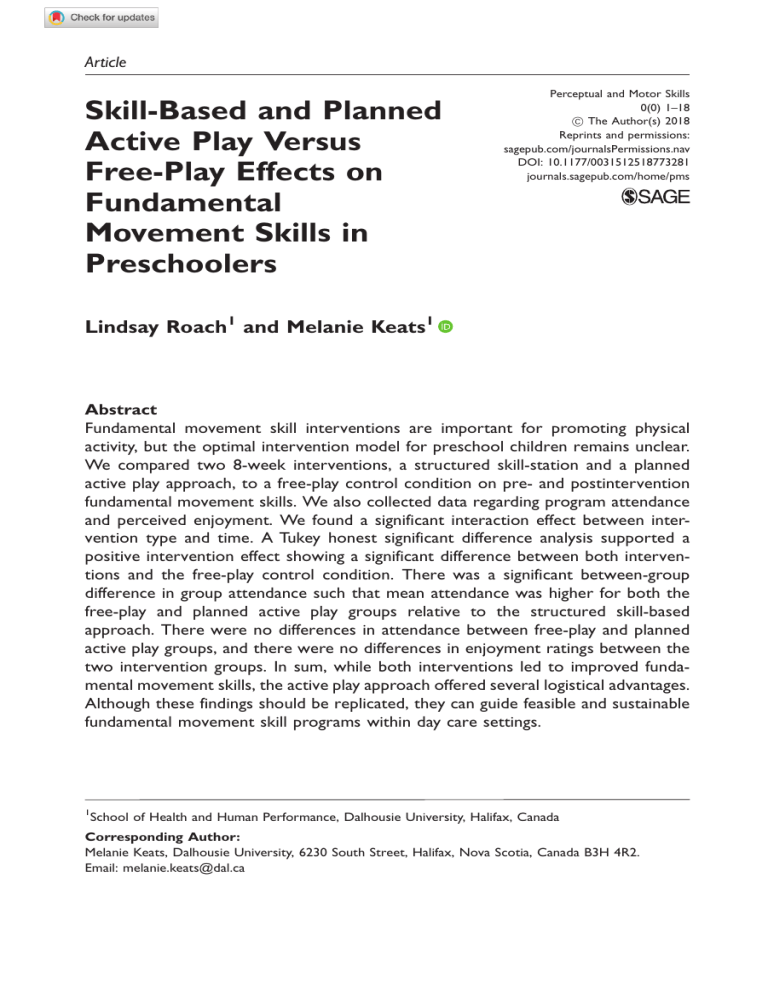
Article Skill-Based and Planned Active Play Versus Free-Play Effects on Fundamental Movement Skills in Preschoolers Perceptual and Motor Skills 0(0) 1–18 ! The Author(s) 2018 Reprints and permissions: sagepub.com/journalsPermissions.nav DOI: 10.1177/0031512518773281 journals.sagepub.com/home/pms Lindsay Roach1 and Melanie Keats1 Abstract Fundamental movement skill interventions are important for promoting physical activity, but the optimal intervention model for preschool children remains unclear. We compared two 8-week interventions, a structured skill-station and a planned active play approach, to a free-play control condition on pre- and postintervention fundamental movement skills. We also collected data regarding program attendance and perceived enjoyment. We found a significant interaction effect between intervention type and time. A Tukey honest significant difference analysis supported a positive intervention effect showing a significant difference between both interventions and the free-play control condition. There was a significant between-group difference in group attendance such that mean attendance was higher for both the free-play and planned active play groups relative to the structured skill-based approach. There were no differences in attendance between free-play and planned active play groups, and there were no differences in enjoyment ratings between the two intervention groups. In sum, while both interventions led to improved fundamental movement skills, the active play approach offered several logistical advantages. Although these findings should be replicated, they can guide feasible and sustainable fundamental movement skill programs within day care settings. 1 School of Health and Human Performance, Dalhousie University, Halifax, Canada Corresponding Author: Melanie Keats, Dalhousie University, 6230 South Street, Halifax, Nova Scotia, Canada B3H 4R2. Email: [email protected] 2 Perceptual and Motor Skills 0(0) Keywords child motor development, intervention, early childhood, physical activity, active play, skill Introduction A wealth of evidence has demonstrated that higher physical activity (PA) is positively associated with a number of health benefits in young children and across the life span (Hinkley, Crawford, Salmon, Okely, & Hesketh, 2008; Janssen & Leblanc, 2010; Timmons et al., 2012; Tucker, 2008; Warburton, Nicol, & Bredin, 2006). Although recent data show that most Canadian preschool-aged children (3–4 years old) meet current daily PA guidelines (i.e., 180 minutes of total daily activity at any intensity; Tremblay et al., 2012), as few as 7% of children 5–11 years of age meet the recommended guidelines of 60 minutes of daily moderate-to-vigorous PA (Colley et al., 2013; Tremblay et al., 2011). Of interest, Colley et al. (2013) found that when using the minimum criteria of 60 minutes of moderate intensity activity versus 180 minutes of total PA, only 11% of children 3–4 years of age would meet guidelines as the bulk of their waking hours (41%) are spent engaged in light activity. As higher PA rates in school-aged youth correlate with greater adult PA participation rates (Telama et al., 2005, 2014), the preschool developmental period is critical for promoting PA (Goldfield, Harvey, Grattan, & Adamo, 2012; Telama, 2009). Parents and care providers have more control over a child’s social and physical environment during the developmentally malleable preschool years than later in development, thus presenting a timely opportunity to intervene and cultivate positive health behaviors and lifestyle choices (Goldfield et al., 2012). Early development of fundamental movement skills (FMS; i.e., basic movement skills including locomotor skills, such as running and jumping, and object control skills, such as catching and throwing) focuses on what Stodden et al. (2008) have termed the ABC’s of movement. The development of these skills has been shown to predict future PA participation, as they form the basis of the specialized movement skills required to participate in recreational and organized activities/sport (Barnett, van Beurden, Morgan, Brooks, & Beard, 2009; Cliff, Okely, Smith, & McKeen, 2009; Cohen, Morgan, Plotnikoff, Callister, & Lubans, 2014; Fisher et al., 2005; Holfelder & Schott, 2014; Williams et al., 2009). Importantly, research has shown that children with superior locomotor skills are more likely to spend more time engaged in nonsedentary behaviors and moderate-to-vigorous levels of PA than children with poorer locomotor skill performance (Williams et al., 2008). Similarly, early development of object control skills has been associated with higher perceived sport competence, increased PA and sport participation, and physical fitness (Barnett et al., 2009). Roach and Keats 3 As many as 33% of Canadian (Sinha, 2014) and 58% of American (United States Department of Education, 2012) parents of children under five years of age rely on day care services, making the day care setting a viable and developmentally appropriate context for fostering FMS acquisition and improvement and for promoting PA (Bower et al., 2008; Goldfield et al., 2012; Ward, 2010). Despite these promising possibilities, systematic research reviews have unveiled few studies examining the day care-based FMS interventions (Riethmuller, Jones, & Okely, 2009; Veldman, Jones, & Okely, 2016). Moreover, while FMS interventions are important for promoting PA (Figueroa & An, 2017) and related health outcomes (Cohen, Morgan, Plotnikoff, Barnett, & Lubans, 2015; Hinkley et al., 2014; Tremblay et al., 2012), no optimal intervention model has emerged (Veldman et al., 2016). As FMS must be learned, practiced, and reinforced (Goodway, Crowe, & Ward, 2003; Logan, Robinson, Wilson, & Lucas, 2012), it is not surprising to discover that higher doses of early intervention efforts may play a key role in overall FMS effectiveness (Veldman et al., 2016). Moreover, as studies have shown that ‘‘free-play’’ is often insufficient for fostering FMS development (Logan et al., 2012), most research has emphasized traditional, direct skill-based instruction. Much less is known about planned, active play with instructor encouragement. As traditional motor skill interventions may become repetitive and less enjoyable over time, children may be more likely to abandon skill-based intervention activities (Logan et al., 2012). As play (Pellegrini & Smith, 1998) and activity enjoyment (Allender, Cowburn, & Foster, 2006; Bremer & Cairney, 2016) has been shown to be critical to a child’s development and continued PA participation, this study examined the effectiveness of different day care-based instructional approaches for improving FMS and for eliciting program adherence and perceived enjoyment. Specifically, we compared (a) a traditional structured, skill-station approach (i.e., direct instruction), (b) a planned, active play approach with instructor encouragement, and (c) a free-play control group while also assessing children’s adherence to and enjoyment of each of the interventions. Method Study Design and Participants The current study employed a cluster-randomized design and observed pre- to postintervention effects at the participant level. We invited participation from a convenience sample of attendees at three day care centers affiliated with the same day care academy. The day cares were selected based on their standardized daily curriculum, weekly meal plans, and adoption of an active, play-based learning environment. Following approval from the day care director, we randomly allocated each of the three centers to one of the three study arms: skill-station, 4 Perceptual and Motor Skills 0(0) planned active play, or free-play control. Two hundred potentially eligible children and their parents/guardians were sent a letter of invitation to participate from the Directors of each participating center. Children were eligible to participate if they were 3–5 years of age at the time of study initiation, had sufficient understanding of English to comprehend study instructions, and had no preexisting motor impairment that would limit their ability to safely participate or adversely affect motor skill testing. Only those children whose parents gave informed written consent were included in the study intervention and assessments. A total of 68 children were enrolled in the study. After accounting for drop-out and missed testing sessions, 19 children (10 males and 9 females) were included in the free-play control group (M ¼ 3.62; SD ¼ 0.41 years), 16 (10 males and 6 females) completed the skill-station-based intervention (M ¼ 4.0; SD ¼ 0.53 years), and 16 (6 males and 10 females) completed the planned, active play intervention (M ¼ 4.29; SD ¼ 0.78 years; see Figure 1 for a participant flowchart). Invited to Participate (n=200) Received Parental Consent (n=68) Not Eligible (n=6) Center Randomization Free-Play Control (n=24) Skill Station Group (n=24) Structured Play Group (n=24) Missed Baseline Testing (n=1) Missed Baseline Testing (n=1) Missed Baseline Testing (n=1) Drop Out (n=3) Drop Out (n=2) Drop Out (n=1) Missed Final Testing (n=1) Missed Final Testing (n=1) Analyzed (n=19) Figure 1. Participant flow. Analyzed (n=16) Analyzed (n=16) Roach and Keats 5 Procedures This study was reviewed and approved by the University Research Ethics Board. Both intervention protocols consisted of two, 45-minute training sessions per week over an 8-week period (totaling 16 training sessions). Total instructional time (i.e., excluding warm-up/cool-down activities) for both interventions was approximately 560 minutes (35 minutes/session; 70 minutes/week). Sessions were held during the predetermined outdoor (weather permitting) gross-motor play periods, and kinesiology student volunteers were recruited and trained to assist with program delivery. All participating children were asked to assent to participate at each biweekly training session; thus giving them the option to choose not to take part in the investigator-led activities on any given day. Attendance at each session was recorded. The free-play control group continued with their standard daily curriculum, permitting children to select and engage in any activity of their choosing without specific instruction. Children in the control group had access to an outdoor play area with free space, ample toys, and loose parts to facilitate unstructured free-play. The lead researcher was present at one 45-minute session per week to observe play behaviors and obtain attendance from the day care director for the second 45-mintute period. We assessed baseline FMS proficiency using the second edition of the Test of Gross Motor Development (TGMD-2; Ulrich, 2000). We collected and scored raw scores (for each subtest and overall score) according to the TGMD-2 manual to enable comparison of our participants to standardized age and sexrelated norms. Following the 8-week interventions, these measurements were repeated for comparison. All TGMD-2 assessments were completed by an experienced investigator with the help of two trained research assistants. Each assessment required approximately 15 to 20 minutes per child to administer. Research staff were not blinded to group allocation. Following the completion of the study, all participating centers received a summary of study results and copies of all intervention tools and resources. Movement Interventions Skill-based. The skill-based station intervention was based on the previously validated Successful Kinesthetic Instruction for Preschoolers program designed to foster the development of FMS in preschool-aged children (Goodway & Branta, 2003; Goodway et al., 2003). A direct instruction approach was used, and each station was supervised by a trained volunteer instructor. We delivered the program outdoors in a sectioned-off portion of the common play area. We modified the Successful Kinesthetic Instruction for Preschoolers program to include an equal emphasis on balance, locomotor, and object control 6 Perceptual and Motor Skills 0(0) skills over the course of the 8-week intervention. The program consisted of a circuit of four skill stations completed in smaller groups (4–5 children/station). Children rotated through all four stations during each session and received task instruction/demonstration, encouragement, and feedback from the trained volunteers. Each week consisted of two different lesson plans, focusing on a specific skill or set of skills. Weeks 1 and 2 focused on balance tasks, Weeks 3 and 4 emphasized locomotor skills, and Weeks 5 and 6 targeted object control skills. Weeks 7 and 8 included a variety of activities with a mix of balance, locomotor, and object control skills (see Appendix for an outline of the intervention). Planned active play. We developed the planned active play intervention using the Active for Life lesson plan builder which incorporates a bank of age-appropriate games developed to improve balance, locomotor, and object control skills (Active for Life, n.d.; see Appendix for an outline of the intervention.) Sessions were conducted in either an indoor gymnasium (weather dependent) or an outdoor recreational field located in close proximity to the center. Two volunteer instructors assisted with the delivery of the intervention (i.e., task demonstration, verbal cueing—‘‘gallop like a horse,’’ and encouragement). Instrumentation FMS development. We used the TGMD-2 (Ulrich, 2000) to measure pre- and postintervention gross motor ability. The TGMD-2 is a highly reliable and valid tool, ideal for identifying delays or improvement in development and for evaluating the success of motor skill interventions. It also uses a qualitative, processoriented approach, considered essential when working with such young children (Goshi, Demura, Kasuga, Sato, & Minami, 1999). Twelve skills are observed, including six object control (stationary strike and dribble, catch, kick, underhand roll, and overhand throw), and six locomotor skills (run, hop, gallop, leap, horizontal jump, and slide). Following demonstration and verbal description of the task, children were allowed a practice trial followed by two test trials. We used the age-referenced composite score of the locomotor and object control subtests (i.e., gross motor quotient: GMQ) as the representative score for all participants, as it has been judged the most reliable method of interpreting TGDM-3 cores (Ulrich, 2000). Baseline and post-intervention GMQ results for all participants were determined, and values were compared to normative percentile scores. Activity enjoyment. Children’s enjoyment in the intervention activities was assessed with a 7-point self-report Likert scale, adapted from the patient mood assessment scale by Lorish and Maisiak (1986) which incorporates various levels of Roach and Keats 7 enjoyment, ranging from a very happy (1) to a very unhappy (7) face. The original 20-face ‘‘Face Scale’’ demonstrated good convergent and discriminant validity and test–retest reliability (0.81) in previous research (Lorish & Maisiak, 1986). Although more precise tools to assess PA enjoyment are available (Imms, 2008; Kendzierski & De Carlo, 1991), they have not been designed for very young children. This simple and visual representation of enjoyment was face valid and easily understood. In cases where the children misunderstood the task (e.g., colored the entire scale), a member of the research team assisted the child in completing the scale. We assessed enjoyment each week for both intervention groups and have reported results as a group average. Statistical Analyses Data management and analyses were conducted using IBM SPSS Statistics for Windows Version 23. We used a one-way analysis of variance to explore differences in program attendance. A three-group, mixed factorial analysis of variance examined the impact of group assignment on GMQ scores over time, and we ran a follow-up Tukey honest significant difference post hoc comparison and computed and reported effect sizes (Cohen, 1988) to further explore between group effects. We compared enjoyment ratings between the two intervention groups with a Kruskal–Wallis H test. Results We detected a significant between-group difference, F(2, 48) ¼ 7.037, p ¼ .002) in group attendance. Post hoc Tukey honest significant difference testing showed that the mean attendance for the free-play (M ¼ 14.58; SD ¼ 2.24; p ¼ .002) and planned active play groups (M ¼ 13.43; SD ¼ 2.66; p ¼ .03) were significantly higher than those for the structured skill-based approach (M ¼ 11.63; SD ¼ 2.31). Attendance for the free-play and planned active play groups did not differ significantly. A summary of pre- and postintervention TGMD-2 subscale and GMQ data is presented in Table 1. A significant main GMQ effect for time, F(1, 48) ¼ 58.4, p < .05, 2p ¼ 0.55, was evident. A main effect for intervention on GMQ scores approached (but did not reach) statistical significance, F(2, 48) ¼ 3.11, p ¼ .054, 2p ¼ 0.12. There was a statistically significant interaction effect between intervention type and time, F(2, 48) ¼ 14.4, p < .005, ¼ 0.38. A Tukey honest significant difference critical value of 5.37 demonstrated no significant difference in baseline GMQ scores (Table 1) and supported a positive intervention effect showing a significant difference between both interventions and the free-play control condition (p < .05). We found no significant differences between the 8 Perceptual and Motor Skills 0(0) Table 1. Baseline and Postintervention LM, OC, and GMQ Scores. Baseline LM Group OC Mean SD Mean SD Postintervention GMQ Mean SD LM OC Mean SD Mean SD GMQ Mean SD Free-play 9.68 1.80 10.68 1.83 101.11 9.29 10.32 1.70 10.16 1.17 101.42 7.71 Skill-based 10.06 2.08 10.75 1.95 102.44 10.17 12.56 1.93 11.81 1.60 113.13 9.35 Planned 10.50 1.83 9.63 1.36 100.38 8.26 12.19 1.72 12.00 1.67 112.56 9.18 active play Note. LM ¼ locomotor; OC ¼ object control; GMQ ¼ gross motor quotient. two intervention groups. Analyses of enjoyment scores revealed no significant differences between the skill (M ¼ 2.45; SD ¼ 0.43) and planned active play (M ¼ 2.33; SD ¼ 0.57) intervention groups, 2(1) ¼ 0.934, p ¼ .334. Discussion Although most research to date has endorsed the use of structured skill-based learning, no study has systematically compared this intervention with a planned active play-based intervention for improving FMS ability in preschoolers. The current study addressed this comparison while also controlling for time spent in PA between groups. In brief, using structured, age-appropriate movement-based games (Active for Life, n.d.), we found the planned active play intervention to be equally effective to the skill-based station approach for improving FMS among preschool-aged children. Consistent with the literature and as hypothesized, the free-play control group total TGMD-2 GMQ scores remained essentially unchanged over the duration of the 8-week study (Goodway & Branta, 2003; Ignico, 1991; Jones et al., 2011). Although no improvements in movement ability in the free-play group were found, we do not intend to trivialize the value of freeplay. Free-play provides a multitude of benefits for children’s development, ranging from improved social interaction to increased creativity and problemsolving abilities (Ginsburg, American Academy of Pediatrics Committee on Communications, & American Academy of Pediatrics Committee on Psychosocial Aspects of Child and Family Health, 2007; Maxwell, Mitchell, & Evans, 2008). Thus, although free-play may not improve FMS, it remains vital to children’s overall development and should not be completely sacrificed in favor of more structured activities. Roach and Keats 9 Although both of our interventions fostered equivalent FMS improvements, the relative ease of delivery between the two approaches was notably different. Specifically, the planned active play intervention required a minimum of two trained individuals, while four were required to execute the skill-based lesson plans. Moreover, fluctuations in child attendance had a minimal impact on the group-based activities in the planned active play group, whereas inconsistent participant numbers for the skill-based station groups required activities to be modified at the last minute. When considering the overall feasibility of implementing any new program, staffing requirements must be considered. Day care staff who are already very busy meeting the children’s basic care needs are unlikely to support changes that would require a significantly increased workload. Moreover, the additional help required to fully implement the skill-based station approach would require doubling the minimum student to staff ratio from 8:1 to 4:1 (Province of Nova Scotia, 2016), creating challenging, if not impossible, new demands on day care staff. Bremer and Cairney (2016) recently reviewed the health-related outcomes associated with FMS ability. In addition to highlighting the importance of FMS ability for PA participation, fitness, and a healthy body composition, they also emphasized the significance of participant enjoyment for sustained PA participation. Specifically, children are less likely to remain engaged if they do not enjoy the motor skill activities, particularly in their younger years (Bremer & Cairney, 2016). Although our modified Likert scale was a simplistic means of assessing participant enjoyment, it offered a useful exploration of this variable in a young preschool population. In contrast to our stated hypotheses that planned active play would be perceived as more enjoyable than skill-based programming, we observed no significant differences between our two intervention groups. Although both groups displayed high enjoyment ratings overall, it was interesting to note that children in the planned active play group attended significantly more sessions than those in the skill-based station group. Although attendance is not a direct measure of enjoyment, it is plausible that children who agreed to participate in the weekly sessions may have found the programming more enjoyable than those children who remained with their regular class. Thus, although average enjoyment ratings were similar, it is possible that more children in the skill stations stopped participating. Perhaps, if attendance were made mandatory, the overall enjoyment of this group may have been lower or may have decreased over time. Future and improved efforts to understand participant enjoyment in different types of movement interventions are needed. Limitations A primary limitation of the current study was constrained staff involvement. Research shows that the policies and practices implemented within a childcare 10 Perceptual and Motor Skills 0(0) setting play a major role in children’s development (Bower et al., 2008; Pate, Pfeiffer, Trost, Ziegler, & Dowda, 2004). This is of particular importance at young ages as a child’s behavior is fluid and habits may not be fully formed. By implementing positive health behaviors early these habits may be more likely to solidify and persist throughout life (Goldfield et al., 2012). Within the day care setting, directors and teachers have control over this behavioral malleability; therefore their level of involvement in the intervention substantially influences the long-term sustainability of any positive effects from the intervention. Future research should attend to Increased staff participation and involvement, critical to the successful implementation and evaluation of these programs. Despite high-level administrative support, individual staff support in our study varied. Goldfield et al. (2012) touched on this issue, highlighting how personal beliefs or attitudes toward the importance of PA may affect how willing individual staff members are to facilitate PA participation or the implementation of similar movement interventions. It has been suggested that early childhood educator training may benefit from additional knowledge related to the importance of promoting PA, reducing sedentary behaviors and ways to effectively assist movement development throughout each stage of the preschool years (McGuire, 2012). Interestingly, a recent study by Adamo et al. (2016) found improvements in children’s movement ability solely through increasing teacher involvement and education regarding the importance of PA participation when staff were also provided with additional resources and activity plans to assist implementation. Practical Implications Increasing levels of physical inactivity within the general preschool population pose an immediate and long-term threat to children’s health and well-being. As FMS skills have been associated with increased PA rates both in the short and long term, finding ways to improve FMS ability within the preschool population is essential. Findings from this study better inform physical literacy and movement development for the preschool population. The discovery that free-play alone is insufficient to foster proper movement skill development is not novel, but the discovery that planned active play can provide improvements in movement development that are equal to those created by a structured skill-stationbased approach is significant. An equally important finding was the relative ease with which the planned active play approach could be implemented in the day care daily routine and its reduced requirements for teachers and equipment. These discoveries are extremely important for such a program’s feasibility and successful implementation. Roach and Keats 11 Appendix Table A1. Planned Play Intervention Outline. Week 1 2 3 4 5 Lesson Focus Equipment Lesson 1 Balance Bean bags, benches, buckets, cones, hoops, and low beams Lesson 2 Balance Lesson 1 Balance Balance beams, bean bags, chalk (outdoor), cones, foam blocks, mats, ribbons, ropes, skipping ropes, strings, tape, and thin mats Balance beams, foam blocks, skipping ropes, tape, and thin mats Lesson 2 Lesson 1 Balance (best-of) Locomotion Bean bags and 2 hoops Lesson 2 Locomotion Bean bags and 2 hoops Lesson 1 Locomotion Bean bags and hoops Lesson 2 Locomotion (best-of) Object control Lesson 1 Baskets, bean bags, bowling pins, foam blocks, and hoops Games – – – – – – – – – – Connect it Freeze and thaw Feed the shark Animal balance One-foot hot potato Follow the leader One-foot hot potato Cross the river Line statues Animal balance – – – – – Simon says Cross the river Balance tag Connect it Traffic light – – – – – – – – – – – – – – Simon says Head and shoulders Animal walk/warm-up Move and grab Be free and do like me Bean bag body freeze Move and grab Animal walk Head and shoulders Making shapes Simon says Bean bag body freeze Statue game Island hopping – Follow my throw – Target throwing overhand (continued) 12 Perceptual and Motor Skills 0(0) Table A1. Continued Week 5 6 7 8 Lesson Lesson 2 Lesson 1 Focus Object control Object control Equipment Baskets, bean bags, bowling pins, foam blocks, hoops, inflatable pool, large box, and large container Bean bags, bowling pins, foam blocks, and hoops Lesson 2 Mixed Baskets, bean bags, cones, and hoops Lesson 1 Mixed Lesson 2 Mixed Balance beams, bean bags, bowling pins, chalk (outdoor), foam blocks, ribbons, ropes, skipping ropes, strings, tape, tape (indoor), thin mats, and wood slats Bean bags, benches, buckets, hoops, inflatable pool, large box, large container, and low beams Lesson 1 Mixed Lesson 2 Mixed (best-of) Bean bags and hoops Games – – – – – – – – – Fruit basket Through the hoop Circle bowling Overhand throw to partner’s hoop Target throwing overhand Musical hoops Fill the pool Circle bowling Follow my throw Overhand throw to partner’s hoop Hoop elimination Fruit basket Musical hoops Space bubble Head and shoulders Balance tag One-foot hot-potato Island hopping Target throwing overhand Line statues Cross the river Statue game Bean bag body freeze Circle bowling – – – – – – – – – – – – Simon says Feed the shark Animal walk warm-up Animal walk Through the hoop Fill the pool Traffic light Freeze and thaw Making shapes Move and grab Hoop elimination Musical hoops – – – – – – – – – – – – – – – Roach and Keats 13 Table A2. Structured Skill Station Approach Intervention Outline. Week Lesson(s) 1 1 and 2 Balance Balance disks, tape, and bean bags 2 3 and 4 Balance 3 5 and 6 Locomotion Balance boards, balance disks, exercise balls, skipping ropes, bean bags, and tape Tape, animal cut-outs, hoops, ropes, blocks, (objects to jump over), and bean bags 4 7 and 8 Locomotion Tape, jump ropes, balance beams, hoops, and objects to jump over 5 9 and 10 Object control 6 11 and 12 Object control 7 13 Mixed Balloons, balls to throw, bowling pins/balls, and batting tees with bat and ball Balls to dribble, balls to throw, tape and Bristol board (targets), soccer balls, pylons, and bean bags Balance disks, tape, bean bags, and batting tees with bat and ball 14 Mixed Balance boards, bowling pins/balls, balloons, and jump ropes 15 Mixed Bean bags, exercise balls, soccer balls, and pylons 8 Focus Equipment Skill Stations 1: Balance disk games 2: Imaginary balance beam 3: One-foot stand challenge 4: Bean bag balance 1: Balance boards 2: Exercise ball challenge 3: Balance obstacle course 4: Hop scotch 1: Imaginary beep test (basic) 2: Move like a . . . 3: Jumping obstacle course 4: Follow the Leader 1: Imaginary beep test (advanced) 2: Jump rope 3: Locomotor obstacle course 4: Egg races 1: Balloon kicks 2: Catch and throw 3: Bowling 4: Striking practice 1: Dribble tag 2: Target practice 3: Pairs soccer 4: Bean bag catch 1: 2: 3: 4: 1: 2: 3: 4: 1: 2: 3: 4: Balance disk games Imaginary beep test Hop scotch Striking practice Balance boards Bowling Balloon kicks Jump rope Bean bag catch Exercise ball challenge Simon says Pairs soccer (continued) 14 Perceptual and Motor Skills 0(0) Table A2. Continued Week Lesson(s) 16 Focus Mixed Equipment Balls to dribble, bean bags, animal cut outs, tape, and Bristol board (targets) Skill Stations 1: 2: 3: 4: Dribble tag Bean bag balance Move like a . . . Target practice Acknowledgments We thank the day care academy, the parents, and children who participated in this study. Without their enthusiasm and support, this project would have not been possible. Declaration of Conflicting Interests The author(s) declared no potential conflicts of interest with respect to the research, authorship, and/or publication of this article. Funding The author(s) disclosed receipt of the following financial support for the research, authorship, and/or publication of this article: Roach was supported by a Nova Scotia Innovation and Research Entrance Graduate Scholarship. Ethical Approval Statement This study was approved by the researchers’ institutional Research Ethics Review Board (REB # 2016-3787). All study guardians provided written informed consent for their child to participate in this study. Child participants provided oral assent. ORCID iD Melanie Keats http://orcid.org/0000-0002-3111-5324 References Active for Life. (n.d.). Lesson plan builder. Retrieved from http://activeforlife.com/lessonplans-and-resources/ Adamo, K. B., Wilson, S., Harvey, A. L., Grattan, K. P., Naylor, P. J., Temple, V. A., & Goldfield, G. S. (2016). Does intervening in childcare settings impact fundamental movement skill development? Medicine and Science in Sports and Exercise, 48(5), 926–932. doi:10.1249/MSS.0000000000000838 Allender, S., Cowburn, G., & Foster, C. (2006). Understanding participation in sport and physical activity among children and adults: A review of qualitative studies. Health Education Research, 21(6), 826–835. Roach and Keats 15 Barnett, L. M., van Beurden, E., Morgan, P. J., Brooks, L. O., & Beard, J. R. (2009). Childhood motor skill proficiency as a predictor of adolescent physical activity. Journal of Adolescent Health, 44(3), 252–259. doi:10.1016/j.jadohealth.2008.07.004 Bower, J. K., Hales, D. P., Tate, D. F., Rubin, D. A., Benjamin, S. E., & Ward, D. S. (2008). The childcare environment and children’s physical activity. American Journal of Preventive Medicine, 34(1), 23–29. doi:10.1016/j.amepre.2007.09.022 Bremer, E., & Cairney, J. (2016). Fundamental movement skills and health-related outcomes: A narrative review of longitudinal and intervention studies targeting typically developing children. American Journal of Lifestyle Medicine. Advance online publication. doi:10.1177/1559827616640196 Cliff, D. P., Okely, A. D., Smith, L. M., & McKeen, K. (2009). Relationships between fundamental movement skills and objectively measured physical activity in preschool children. Pediatric Exercise Science, 21(4), 436–449. Cohen, J. (1988). Statistical power analysis for the behavioral sciences (2nd ed.). Hillsdale, NJ: Erlbaum. Cohen, K. E., Morgan, P. J., Plotnikoff, R. C., Barnett, L. M., & Lubans, D. R. (2015). Improvements in fundamental movement skill competency mediate the effect of the SCORES intervention on physical activity and cardiorespiratory fitness in children. Journal of Sports Sciences, 33(18), 1908–1918. doi:10.1080/02640414.2015. 1017734 Cohen, K. E., Morgan, P. J., Plotnikoff, R. C., Callister, R., & Lubans, D. R. (2014). Fundamental movement skills and physical activity among children living in lowincome communities: A cross-sectional study. International Journal of Behavioral Nutrition and Physical Activity, 11(1), 49. doi:10.1186/1479-5868-11-49 Colley, R. C., Garriguet, D., Adamo, K. B., Carson, V., Janssen, I., Timmons, B. W., & Tremblay, M. S. (2013). Physical activity and sedentary behavior during the early years in Canada: A cross-sectional study. International Journal of Behavioral Nutrition and Physical Activity, 10, 54. doi:10.1186/1479-5868-10-54 Figueroa, R., & An, R. (2017). Motor skill competence and physical activity in preschoolers: A review. Maternal and Child Health Journal, 21(1), 136–146. doi:10.1007/s10995-016-2102-1 Fisher, A., Reilly, J. J., Kelly, L. A., Montgomery, C., Williamson, A., Paton, J. Y., & Grant, S. (2005). Fundamental movement skills and habitual physical activity in young children. Medicine and Science in Sports and Exercise, 37(4), 684–688. Ginsburg, K. R., & American Academy of Pediatrics Committee on Communications, & American Academy of Pediatrics Committee on Psychosocial Aspects of Child and Family Health. (2007). The importance of play in promoting healthy child development and maintaining strong parent-child bonds. Pediatrics, 119(1), 182–191. doi:10.1542/peds.2006-2697 Goldfield, G. S., Harvey, A., Grattan, K., & Adamo, K. B. (2012). Physical activity promotion in the preschool years: A critical period to intervene. International Journal of Environmental Research and Public Health, 9(4), 1326–1342. doi:10.3390/ ijerph9041326 Goodway, J. E., & Branta, C. F. (2003). Influence of a motor skill intervention on fundamental motor skill development of disadvantaged preschool children. Research Quarterly for Exercise and Sport, 74(1), 36–46. doi:10.1080/02701367.2003.10609062 16 Perceptual and Motor Skills 0(0) Goodway, J. E., Crowe, H., & Ward, P. (2003). Effects of motor skill instruction on fundamental motor skill development. Adapted Physical Activity Quarterly, 20, 298–314. Goshi, F., Demura, S., Kasuga, K., Sato, S., & Minami, M. (1999). Selection of effective tests of motor ability in preschool children based on pass-or-fail criteria: Examination of reliability, objectivity, and rate of passing. Perceptual and Motor Skills, 88(1), 169–181. doi:10.2466/pms.1999.88.1.169 Hinkley, T., Crawford, D., Salmon, J., Okely, A. D., & Hesketh, K. (2008). Preschool children and physical activity: A review of correlates. American Journal of Preventive Medicine, 34(5), 435–441. doi:10.1016/j.amepre.2008.02.001 Hinkley, T., Teychenne, M., Downing, K. L., Ball, K., Salmon, J., & Hesketh, K. D. (2014). Early childhood physical activity, sedentary behaviors and psychosocial wellbeing: A systematic review. Preventive Medicine, 62, 182–192. doi:10.1016/ j.ypmed.2014.02.007 Holfelder, B., & Schott, N. (2014). Relationship of fundamental movement skills and physical activity in children and adolescents: A systematic review. Psychology of Sport and Exercise, 15, 382–391. Ignico, A. A. (1991). Effects of a competency-based intruction on kindergarten children’s gross motor development. Physical Educator, 48(4), 188–191. Imms, C. (2008). Review of the children’s assessment of participation and enjoyment and the preferences for activity of children. Physical & Occupational Therapy in Pediatrics, 28(4), 389–404. Janssen, I., & Leblanc, A. G. (2010). Systematic review of the health benefits of physical activity and fitness in school-aged children and youth. The International Journal of Behavioral Nutrition and Physical Activity, 7, 40. doi:10.1186/1479-5868-7-40 Jones, R. A., Riethmuller, A., Hesketh, K., Trezise, J., Batterham, M., & Okely, A. D. (2011). Promoting fundamental movement skill development and physical activity in early childhood settings: A cluster randomized controlled trial. Pediatric Exercise Science, 23(4), 600–615. Kendzierski, D., & De Carlo, K. L. (1991). Physical activity enjoyment scale: Two validation studies. Journal of Sport and Exercise Psychology, 13, 50–64. Logan, S. W., Robinson, L. E., Wilson, A. E., & Lucas, W. A. (2012). Getting the fundamentals of movement: A meta-analysis of the effectiveness of motor skill interventions in children. Child: Care, Health and Development, 38(3), 305–315. doi:10.1111/j.1365-2214.2011.01307.x Lorish, C. D., & Maisiak, R. (1986). The face scale: A brief, nonverbal method for assessing patient mood. Arthritis and Rheumatism, 29(7), 906–909. Maxwell, L. E., Mitchell, M. R., & Evans, G. W. (2008). Effects of play equipment and loose parts on preschool children’s outdoor play behavior: An observational study and design intervention. Children Youth and Environments, 18(2), 36–63. McGuire, S. (2012). Institute of Medicine (IOM) early childhood obesity prevention policies. Washington, DC: The National Academies Press; 2011. Advances in Nutrition, 3(1), 56–57. doi:10.3945/an.111.001347 Pate, R. R., Pfeiffer, K. A., Trost, S. G., Ziegler, P., & Dowda, M. (2004). Physical activity among children attending preschools. Pediatrics, 114(5), 1258–1263. doi:10.1542/peds.2003-1088-L Roach and Keats 17 Pellegrini, A. D., & Smith, P. K. (1998). The development of play during childhood: Forms and possible functions. Child and Adolescent Mental Health, 3(2), 51–57. Province of Nova Scotia. (2016). Day care regulations. Retrieved from http://www.novascotia. ca/just/regulations/regs/dayregs.html Riethmuller, A. M., Jones, R., & Okely, A. D. (2009). Efficacy of interventions to improve motor development in young children: A systematic review. Pediatrics, 124(4), e782–e792. doi:10.1542/peds.2009-0333 Sinha, M. (2014). Child care in Canada (Catalogue No. 89-652, No. 005). Ottawa, Canada: Statistics Canada. Stodden, D. F., Goodway, J. D., Langendorfer, S. J., Roberton, M. A., Rudisill, M. E., Garcia, C., & Garcia, L. E. (2008). A developmental perspective on the role of motor skill competence in physical activity: An emergent relationship. Quest, 60(2), 290–306. Telama, R. (2009). Tracking of physical activity from childhood to adulthood: A review. Obesity Facts, 2(3), 187–195. doi:10.1159/000222244 Telama, R., Yang, X., Leskinen, E., Kankaanpaa, A., Hirvensalo, M., Tammelin, T., . . . Raitakari, O. T. (2014). Tracking of physical activity from early childhood through youth into adulthood. Medicine and Science in Sports and Exercise, 46(5), 955–962. doi:10.1249/MSS.0000000000000181 Telama, R., Yang, X., Viikari, J., Valimaki, I., Wanne, O., & Raitakari, O. (2005). Physical activity from childhood to adulthood: A 21-year tracking study. American Journal of Preventive Medicine, 28(3), 267–273. doi:10.1016/j.amepre.2004.12.003 Timmons, B. W., Leblanc, A. G., Carson, V., Connor Gorber, S., Dillman, C., Janssen, I., . . . Tremblay, M. S. (2012). Systematic review of physical activity and health in the early years (aged 0-4 years). Applied Physiology, Nutrition, and Metabolism, 37(4), 773–792. doi:10.1139/h2012-070 Tremblay, M. S., Leblanc, A. G., Carson, V., Choquette, L., Connor Gorber, S., Dillman, C., . . . Canadian Society for Exercise Physiology (2012). Canadian physical activity guidelines for the early years (aged 0-4 years). Applied Physiology, Nutrition, and Metabolism, 37(2), 345–369. doi:10.1139/h2012-018 Tremblay, M. S., Warburton, D. E., Janssen, I., Paterson, D. H., Latimer, A. E., Rhodes, R. E., . . . Duggan, M. (2011). New Canadian physical activity guidelines. Applied Physiology, Nutrition, and Metabolism, 36(1), 36–46; 47–58. doi:10.1139/H11-009 Tucker, P. (2008). The physical activity levels of preschool-aged children: A systematic review. Early Childhood Research Quarterly, 23, 547–558. United States Department of Education. (2012). Enrollment of 3-, 4-, and 5-year old children in preprimary programs by level of program, control of program, and attendance status: Selected years 1965 through 2011. Washington, DC: Author. Ulrich, D. A. (2000). Test of gross motor development: Examiners manual (2nd ed.). Austin, Texas: Pro-ED Inc. Veldman, S. L., Jones, R. A., & Okely, A. D. (2016). Efficacy of gross motor skill interventions in young children: An updated systematic review. BMJ Open Sport & Exercise Medicine, 2(1), e000067. doi:10.1136/bmjsem-2015-000067 Warburton, D. E., Nicol, C. W., & Bredin, S. S. (2006). Health benefits of physical activity: The evidence. CMAJ: Canadian Medical Association Journal, 174(6), 801–809. doi:10.1503/cmaj.051351 18 Perceptual and Motor Skills 0(0) Ward, D. S. (2010). Physical activity in young children: The role of child care. Medicine and Science in Sports and Exercise, 42(3), 499–501. doi:10.1249/ MSS.0b013e3181ce9f85 Williams, H. G., Pfeiffer, K. A., Dowda, M., Jeter, C., Jones, S., & Pate, R. R. (2009). A field-based testing protocol for assessing gross motor skills in preschool children: The CHAMPS motor skills protocol (CMSP). Measurement in Physical Education and Exercise Science, 13(3), 151–165. doi:10.1080/10913670903048036 Williams, H. G., Pfeiffer, K. A., O’Neill, J. R., Dowda, M., McIver, K. L., Brown, W. H., & Pate, R. R. (2008). Motor skill performance and physical activity in preschool children. Obesity, 16(6), 1421–1426. doi:10.1038/oby.2008.214. Author Biographies Lindsay Roach, MSc, completed this project for her thesis research in the School of Health and Human Performance, Division of Kinesiology at Dalhousie University. She is currently completing her graduate degree in physiotherapy at Dalhousie University. Melanie Keats, PhD, is an associate professor in the School of Health and Human Performance, Division of Kinesiology at Dalhousie University.


